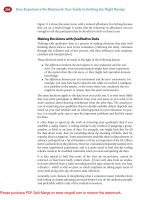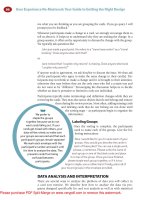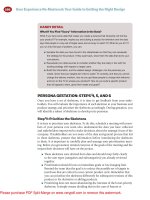Bluetooth low energy in android java your guide to programming the internet of things
Bạn đang xem bản rút gọn của tài liệu. Xem và tải ngay bản đầy đủ của tài liệu tại đây (8.24 MB, 1,156 trang )
Bluetooth Low Energy in Android
Java
1st Edition
Tony Gaitatzis
BackupBrain Publishing, 2017
ISBN: 978-1-7751280-1-4
backupbrain.co
Bluetooth Low Energy in Android
Java
by Tony Gaitatzis
Copyright © 2015 All Rights Reserved
All rights reserved. This book or any portion thereof
may not be reproduced or used in any manner
whatsoever without the express written permission of
the publisher except for the use of brief quotations in a
book review. For permission requests, write to the
publisher, addressed “Bluetooth Android Book Reprint
Request,” at the address below.
This book contains code samples available under the
MIT License, printed below:
Permission is hereby granted, free of charge, to any
person obtaining a copy of this software and associated
documentation files (the "Software"), to deal in the
Software without restriction, including without
limitation the rights to use, copy, modify, merge,
publish, distribute, sublicense, and/or sell copies of the
Software, and to permit persons to whom the Software
is furnished to do so, subject to the following
conditions:
The above copyright notice and this permission notice
shall be included in all copies or substantial portions of
the Software.
THE SOFTWARE IS PROVIDED "AS IS",
WITHOUT WARRANTY OF ANY KIND, EXPRESS
OR IMPLIED, INCLUDING BUT NOT LIMITED TO
THE WARRANTIES OF MERCHANTABILITY,
FITNESS FOR A PARTICULAR PURPOSE AND
NONINFRINGEMENT. IN NO EVENT SHALL THE
AUTHORS OR COPYRIGHT HOLDERS BE
LIABLE FOR ANY CLAIM, DAMAGES OR
OTHER LIABILITY, WHETHER IN AN ACTION
OF CONTRACT, TORT OR OTHERWISE, ARISING
FROM, OUT OF OR IN CONNECTION WITH THE
SOFTWARE OR THE USE OR OTHER DEALINGS
IN THE SOFTWARE.
(this page intentionally left blank)
Dedication
To Sierra, for lending me a phone
and Bruno for being much more thorough than I could
ever be.
(this page intentionally left blank)
Preface
Thank you for buying this book. I’m excited to have
written it and more excited that you are reading it.
I started with Bluetooth Low Energy in 2011 while
making portable brain imaging technology. Later,
while working on a friend’s wearable electronics
startup, I ended up working behind teh scenes on the
TV show America’s Greatest Makers in the Spring of
2016.
Coming from a web programming background, I found
the mechanics and nomenclature of BLE confusing and
cryptic. A er immersing myself in it for a period of
time I acclimated to the di erences and began to
appreciate the power behind this low-power
technology.
Unlike other wireless technologies, BLE can be
powered from a coin cell battery for months at a time perfect for a wearable or Internet of Things (IoT)
project! Because of its low power and short data
transmissions, it is great for transmitting bite size
information, but not great for streaming data such as
sound or video.
Good luck and enjoy!
Section 1
Conventions Used in this Book
Every developer has their own coding conventions. I
personally believe that well-written code is selfexplanatory. Moreover, consistent and organized
coding conventions let developers step into each
other’s code much more easily, enabling them to
reliably predict how the author has likely organized
and implemented a feature, thereby making it easier to
learn, collaborate, fix bugs and perform upgrades.
The coding conventions I used in this book is as
follows:
Inline comments are as follows:
// inline comments
Multiline comments follow the JavaDoc standard:
/**
* This is a multiline comment
* It features more than one line of comment
*/
Constants are written in all capitals:
public static final int CONSTANT_NAME = 0x01;
Local variables are written in Camel Case:
int MemberVariableName = 1;
Member variables are written in Camel Case with a
lowercase “m” preceding the name.
private int mMemberVariableName = 1;
Function declarations are in Camel Case. In cases
where there isn’t enough space to write the whole
function on a line, parameters are written on another
line:
void shortFunction() {
}
void superLongFunctionName(int parameterOne,
int parameterTwo) {
...
}
Class names are in Camel Case with the first character
in upper case
public ClassName {
...
}
Long lines will be broken with a backslash ( \ ) and the
next line will be indented:
static final String
SOME_REALLY_LONG_VARIABE_NAME_WILL_BE_BROKEN = \
"onto the next line";
CHAPTER 1
Introduction
In this book you will learn the basics of how to
program Central and Peripheral devices that
communicate over Bluetooth Low Energy using Java
on Android. These tutorials will culminate in three
projects:
A Beacon and Scanner
A Echo Server and Client
A Remote Controlled Device
Through the course of the book you will learn
important concepts that relate to:
How Bluetooth Low Energy works,
How data is sent and received
Common paradigms for handling data
This book is an excellent read for anyone familiar with
Android programming, who wants to build an Internet
of Things device or a tool that communicates with a
Bluetooth device.
Overview
Bluetooth Low Energy (BLE) is a digital radio
protocol. Very simply, it works by transmitting radio
signals from one computer to another.
Bluetooth supports a hub-and-spoke model of
connectivity. One device acts as a hub, or “Central” in
Bluetooth terminology. Other devices act as
“Peripherals.”
A Central may hold several simultaneous connections
with a number of peripherals, but a peripheral may
only hold one connection at a time (Figure 1-1). Hence
the names Central and Peripheral.
Figure 1-1. Bluetooth network topology
For example, your smartphone acts as a Central. It may
connect to a Bluetooth speaker, lamp, smartwatch, and
fitness tracker. Your fitness tracker and speaker, both
Peripherals, can only be connected to one smartphone
at a time.
The Central has two modes: scanning and connected.
The Peripheral has two modes: advertising and
connected. The Peripheral must be advertising for the
Central to see it.
Advertising
A Peripheral advertises by advertising its device name
and other information on one radio frequency, then on
another in a process known as frequency hopping. In
doing so, it reduces radio interference created from
reflected signals or other devices.
Scanning
Similarly, the Central listens for a server’s
advertisement first on one radio frequency, then on
another until it discovers an advertisement from a
Peripheral. The process is not unlike that of trying to
find a good show to watch on TV.
The time between radio frequency hops of the scanning
Central happens at a different speed than the frequency
hops of the advertising Peripheral. That way the scan
and advertisement will eventually overlap so that the
two can connect.
Each device has a unique media access control address
(MAC address) that identifies it on the network.
Peripherals advertise this MAC address along with
other information about the Peripheral’s settings.
Connecting
A Central may connect to a Peripheral after the Central
has seen the Peripheral’s advertisement. The
connection involves some kind of handshaking which
is handled by the devices at the hardware or firmware
level.
While connected, the Peripheral may not connect to
any other device.
Disconnecting
A Central may disconnect from a Peripheral at any
time. The Peripheral is aware of the disconnection.
Communication
A Central may send and request data to a Peripheral
through something called a “Characteristic.”
Characteristics are provided by the Peripheral for the
Central to access. A Characteristic may have one or
more properties, for example READ or WRITE. Each
Characteristic belongs to a Service, which is like a
container for Characteristics. This paradigm is called
the Bluetooth Generic Attribute Profile (GATT).
The GATT paradigm is laid out as follows (Figure 12).
Figure 1-2. Example GATT Structure
To transmit or request data from a Characteristic, a
Central must first connect to the Characteristic’s
Service.
For example, a heart rate monitor might have the
following GATT profile, allowing a Central to read the
beats per minute, name, and battery life of the server
(Figure 1-3).
Figure 1-3. Example GATT structure for a heart monitor
In order to retrieve the battery life of the Characteristic,
the Central must be connected also to the Peripheral’s
“Device Info” Service.
Because a Characteristic is provided by a Peripheral,
the terminology refers to what can be done to the
Characteristic. A “write” occurs when data is sent to
the Characteristic and a “read” occurs when data is
downloaded from the Characteristic.
To reiterate, a Characteristic is a field that can be
written to or read from. A Service is a container that
may hold one or more Characteristics. GATT is the
layout of these Services and Characteristics.
Characteristic can be written to or read from.
Byte Order
Bluetooth orders data in both Big-Endian and LittleEndian depending on the context.
During advertisement, data is transmitted in Big
Endian, with the most significant bytes of a number at
the end (Figure 1-4).
Figure 1-4. Big Endian byte order
Data transfers inside the GATT however are
transmitted in Little Endian, with the least significant
byte at the end (Figure 1-5).
Figure 1-5. Little Endian byte order
Permissions
A Characteristic grants certain Permissions of the
Central. These permissions include the ability to read
and write data on the Characteristic, and to subscribe to
Notifications.
Descriptors
Descriptors describe the configuration of a
Characteristic. The only one that has been specified so
far is the “Notification” flag, which lets a Central
subscribe to Notifications.
UUIDs
A UUID, or Universally Unique IDentifier is a very
long identifier that is likely to be unique, no matter
when the UUID was created or who created it.
BLE uses UUIDs to label Services and Characteristics
so that Services and Characteristics can be identified
accurately even when switching devices or when
several Characteristics share the same name.
For example, if a Peripheral has two “Temperature”
Characteristics - one for Celsius and the other in
Fahrenheit, UUIDs allow for the right data to be
communicated.
UUIDs are usually 128-bit strings and look like this:
ca06ea56-9f42-4fc3-8b75-e31212c97123
But since BLE has very limited data transmission, 16bit UUIDs are also supported and can look like this:
0x1815
Each Characteristic and each Service is identified by its
own UUID. Certain UUIDs are reserved for specific
purposes.
For example, UUID 0x180F is reserved for Services
that contain battery reporting Characteristics.
Similarly, Characteristics have reserved UUIDs in the
Bluetooth Specification.
For example, UUID 0x2A19 is reserved for
Characteristics that report battery levels.
A list of UUIDs reserved for specific Services can be
found in Appendix IV: Reserved GATT Services.
A list of UUIDs reserved for specific Characteristics
can be in Appendix V: Reserved GATT
Characteristics.
If you are unsure what UUIDs to use for a project, you
are safe to choose an unassigned service (e.g. 0x180C)
for a Service and generic Characteristic (0x2A56).
Although the possibility of two generated UUIDs being
the same are extremely low, programmers are free to
arbitrarily define UUIDs which may already exist. So
long as the UUIDs defining the Services and
Characteristics do not overlap in the a single GATT
Profile, there is no issue in using UUIDs that exist in
other contexts.
Bluetooth Hardware
All Bluetooth devices feature at least a processor and
an antenna (Figure 1-6).









